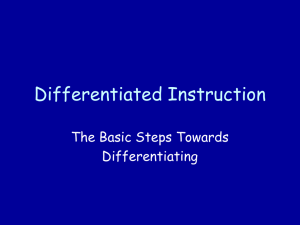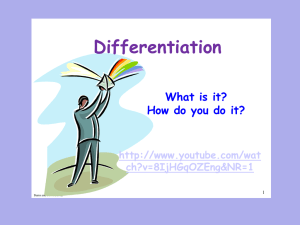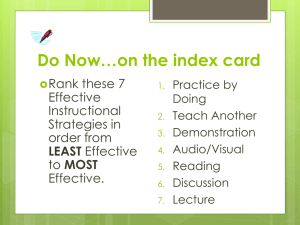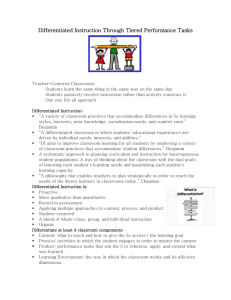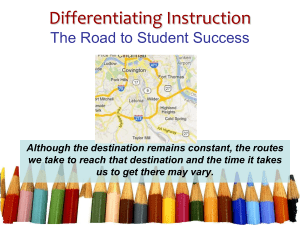Differentiated_Instruction_TMS
advertisement
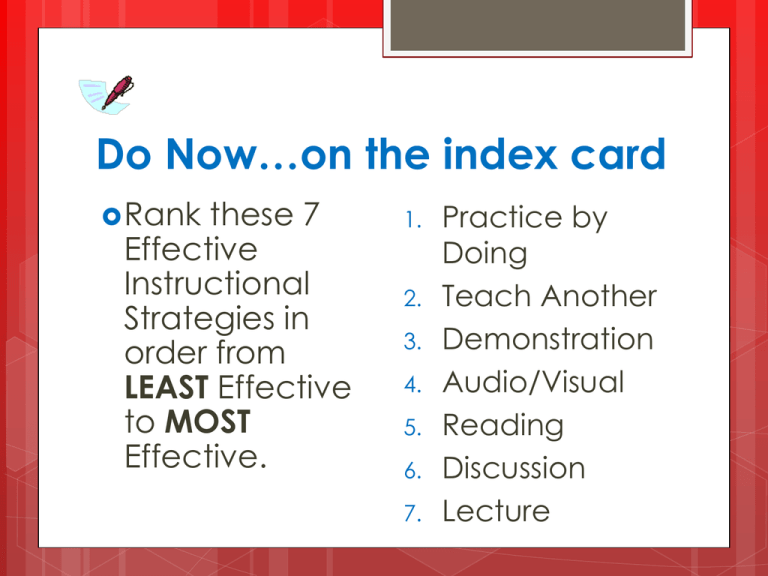
Do Now…on the index card Rank these 7 Effective Instructional Strategies in order from LEAST Effective to MOST Effective. 1. 2. 3. 4. 5. 6. 7. Practice by Doing Teach Another Demonstration Audio/Visual Reading Discussion Lecture Differentiated Instruction The Basic Steps Towards Differentiating July 28, 2015 Ms. Tracey Johnson Treadwell Middle School Agenda Warm Up- “Do Now”- Effective Instructional Strategies Objective & Define Differentiated Instruction Differentiated Instruction Professional Development Presentation D. I.-“Think Aloud” Activity Tiered Assignments Activity Closure: “One thing that Stuck to You” Do Now…on the index card Rank these 7 Effective Instructional Strategies in order from LEAST Effective to MOST Effective. 1. 2. 3. 4. 5. 6. 7. Practice by Doing Teach Another Demonstration Audio/Visual Reading Discussion Lecture How’d You Do??? Lecture 5% Reading 10% Audio/Visuals 20% Demonstration 30% Discussion 50% Practice By Doing 75% Teach Others/Immediate Use Of Learning 95% Let’s Define Differentiated Instruction Objective: By the end of the session, teachers will develop a deeper understanding of Differentiated Instruction. Differentiating instruction is doing what’s fair for students. It means creating multiple paths so that students of different abilities, interests, or learning needs experience equally appropriate ways to learn. Differentiation of Instruction is a teacher’s response to learners’ needs guided by general principles of differentiation such as: respectful tasks flexible grouping ongoing assessment and adjustment Content Readiness ways to differentiate: Process Product according to students’ Interests Learning Profile Traditional Classroom vs. Differentiated Classroom TRADITIONAL Differences are acted upon when problematic. Assessment is most common at the end of learning to see “who got it” A relatively narrow sense of intelligence prevails Coverage of curriculum guides drives instruction Whole class instruction dominates A single text prevails DIFFERENTIATED Differences are studied as a basis for planning. Assessment is on-going and diagnostic to make instruction more responsive to learner needs Focus on multiple forms of intelligences is evident Student readiness, interest, and learning profile shape instruction Many instructional arrangements are used Multiple materials are provided Adapted from “The Differentiated Classroom: Responding to the Needs of All Learners,” by Carol Ann Tomlinson, 1999, p.16 The Rationale for Differentiated Instruction Different levels of readiness Different Interests The Rationale for Differentiated Instruction Different Ability Levels Different Cognitive Needs Teachers can differentiate according to …. The Content (What is Taught) The Process (How it is Taught) The Product (How Learning is Assessed *The Learning Environment (determined by the other 3) Differentiating Content (what is taught) Resource materials at varying readability levels Audio and video recordings Highlighted vocabulary Charts and models Interest centers Varied manipulatives and resources Peer and adult mentors Differentiating Process (making sense and meaning of content) Use leveled or tiered activities Interest centers Hands-on materials Vary pacing according to readiness Allow for working alone, in partners, triads, and small groups Allow choice in strategies for processing and for expressing results of processing Differentiating Products (showing what is known and able to be done) Tiered product choices Model, use and encourage student use of technology within products and presentations Provide product choices that range in choices from all multiple intelligences, options for gender, culture, and race Use related arts teachers to help with student products Strategies to Make Differentiation Work 1. Tiered Instruction Changing the level of complexity or required readiness of a task or unit of study in order to meet the developmental needs of the students involved. Tiering is one of the best approaches because it allows that all students with different learning needs work with the same curriculum. Tiering Key Concept Or Understanding Those who do not know the concept Those with some understanding Those who understand the concept What Can Be Tiered? Processes, content and products Assignments Homework Learning stations Assessments Writing prompts Anchor activities Materials What Can We Adjust? Level of complexity Amount of structure Pacing Materials Concrete to abstract Options based on student interests Options based on learning styles Strategies for Differentiation Confused? Let’s break it down. Differentiation can include complex strategies, like writing tiered lesson plans, or it can take a more simplistic form, such as using reading buddies or think-pair-share strategies. Here is a condensed list of the continuum of differentiated strategies. Higher Prep Strategies Tiered Lessons Flexible Grouping Think-Tac-Toe Multiple Intelligence Options Graphic Organizers Response/Exit Cards Multiple Texts Lower Prep Strategies Reading & Study Buddies Anchor Activities Think-Pair-Share Choices of books Interest Surveys Multiple Levels of Questioning Strategies to Make Differentiation Work 2. Anchoring Activities These are activities that a student may do at any time when they have completed their present assignment or when the teacher is busy with other students. They may relate to specific needs or enrichment opportunities, including problems to solve or journals to write. They could also be part of a long term project. Strategies to Make Differentiation Work 3. Flexible Grouping This allows students to be appropriately challenged and avoids labeling a student’s readiness as a static state. It is important to permit movement between groups because interest changes as we move from one subject to another Flexible Grouping Homogenous/Ability -Clusters students of similar abilities, level, learning style, or interest. -Usually based on some type of pre-assessment Heterogeneous Groups -Different abilities, levels or interest - Good for promoting creative thinking. Individualized or Independent Study -Self paced learning -Teaches time management and responsibility -Good for remediation or extensions Whole Class -Efficient way to present new content -Use for initial instruction Strategies to Make Differentiation Work 4. Compacting Curriculum Compacting the curriculum means assessing a student’s knowledge and skills, and providing alternative activities for the student who has already mastered curriculum content. This can be achieved by pre-testing basic concepts or using performance assessment methods. Students demonstrating they do not require instruction move on to tiered problem solving activities while others receive instruction. Brain Break!!!!! Musical Chairs… As the music plays, move to a table with teachers in the same Subject Area: • Language Arts • Math • Science • Social Studies • SPED • Electives https://www.youtube.com/watch?v=1UrpQTI6HTo&list=PL0wIZwSQJsEXPn3m1YlDk3NjaPwzV0ru8 Strategies to Make Differentiation Work 1. Tiered Instruction Changing the level of complexity or required readiness of a task or unit of study in order to meet the developmental needs of the students involved. What Can Be Tiered? Processes, content and products Assignments Homework Learning stations Assessments Writing prompts Anchor activities Materials Tiering Key Concept Or Understanding Those who do not know the concept Those with some understanding Those who understand the concept Think Aloud 1. 2. How was D.I. utilized in the lesson? What was done with students: A. B. C. 3. Below Grade Level On Grade Level Above Grade Level In what ways are students assessed? Tiering Activity Instruction 1. 2. 3. Identify the standard, concept, or skill you want the students to learn. Decide if students have the background necessary to be successful with the lesson. Assess the students’ readiness, interests, and learning profiles. Tiering Activity Instruction 4. 5. 6. Create an activity or project that is clearly focused on the standard, concept or generalization of the lesson. Adjust the activity to provide different levels or tiers of difficulty that will lead all students to an understanding. Develop an assessment component for the lesson. This can be whole group. Remember, it is on-going! Ebb and Flow of Experiences (Tomlinson) Back and forth over time or course of unit Individual Small Group Whole Group Small Group Individual What Differentiation Is … Student Best Centered practices Different approaches 3 or 4 different activities Multiple approaches to content, process, and product A way of thinking and planning Flexible grouping What Differentiation Isn’t One A Thing 35 different plans for one classroom Program The Goal Hard questions for some and easy for others A chaotic classroom Just homogenous grouping In Summary….. What is fair isn’t always equal… and Differentiation gets us away from “one size fits all” approach to curriculum and instruction that doesn’t fit anyone Closure Write “One Thing That Stuck with You” about Differentiated Instruction! Bibliography Campbell, Bruce. The Multiple Intelligences Handbook: Lesson Plans and More. Stanwood, WA. 1996. Daniels, Harvey and Bizar. (2005). Teaching The Best Practice Way: Methods that Matter, K-12. Portland, Maine: Stenhouse Publishers. Gregory, Gayle. Differentiated Instructional Strategies in Practice. Thousand Oaks, CA. 2003. Tomlinson, Carol Ann. The Differentiated Classroom. Alexandria, VA: ASCD. 1995. Wormeli, Rick. Fair Isn’t Always Equal: Assessment and Grading in the Differentiated Classroom, Stenhouse Publishers, 2006.

